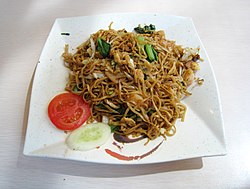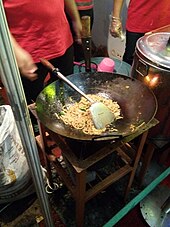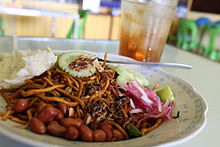Mie goreng
 Mie goreng in a restaurant inJakarta | |
| Alternative names | Bakmi goreng, Mi goreng |
|---|---|
| Type | Noodle |
| Course | Main course |
| Place of origin | Indonesia[1] |
| Region or state | Nationwide |
| Serving temperature | Hot |
| Main ingredients | Fried noodles with chicken, meat or prawn |
Mie goreng(Indonesian:mi goreng;meaning "fried noodles"[2]), also known asbakmi goreng,[3]is anIndonesianstir-fried noodle dish. It is made with thin yellownoodlesstir-fried incooking oilwithgarlic,onionorshallots,friedprawn,chicken,beef,or slicedbakso(meatballs), chili,Chinese cabbage,cabbages,tomatoes,egg,and other vegetables. Ubiquitous in Indonesia, it is sold by food vendors from street hawkers (warungs) to high-end restaurants.
History[edit]

In Indonesia, where mi goreng is one of the most widespread simple dishes, the dish's origin is associated withChinese Indonesian cuisine.[1]Chinese influencesare evident inIndonesian foodsuch asbakmi,mi ayam,pangsit,bakso,lumpia,kwetiau goreng,andmi goreng.[4]The dish is derived from Chinesechow meinand is believed to have been introduced byChinese immigrantsinIndonesia.Despite being influenced by Chinese cuisine,mi gorengin Indonesia has a definite Indonesian taste and has been heavily integrated intoIndonesian cuisine,[5]through, for example, the application ofsweet soy saucethat adds mild sweetness,[6]a sprinkle of friedshallots,and spicysambal.Porkandlardare eschewed in favour of shrimp, chicken, or beef to cater to theMuslimmajority.
Preparation[edit]
Mi gorengis traditionally made withyellow wheat noodles,stir-fried with choppedshallots,onion,andgarlicwithsoy sauceseasoning,egg,vegetables,chicken,meat,orseafood.However, other versions might use driedinstant noodlesinstead of fresh yellow wheat noodles. A common practice in Indonesia is the inclusion of powdered instant noodle seasonings, along with eggs and vegetables. Authenticmi gorenguses fresh ingredients and spices; however, bottled instant spice paste might be used for practical reasons.[7]
The almost identical recipe is often used to create other dishes. For example,bihun gorengis made by replacing yellow wheat noodles withbihun(rice vermicelli), whilekwetiau gorenguseskwetiau(thick flat rice noodles) instead.
Variations[edit]

Somemi gorengvariants exist. In Indonesia,mi gorengvariants are usually named after the ingredients, while some might be named after the region of origin.
- Mi goreng ayamor commonmi gorenguses chicken with shallots, garlic, leek, sweet soy sauce, egg, and vegetables typically added as well.
- Mi goreng ayam penyetmi goreng topped withayam penyetsmashed fried chicken with sambal.
- Mi goreng sapi,is similar to common traditionalmie goreng,but usesbeefinstead.
- Mi goreng kambingusesgoat meatormutton.
- Mi goreng kerangusesclam.It is a specialty ofBatam.[8]
- Mi goreng udangusesshrimp.
- Mi goreng seafoodusesseafoodwhich includes a mixture of fish,squid,and shrimp.
- Mi goreng Acehami gorengvariant fromAcehprovince, uses a thicker noodle similar to that of spaghetti and employs a curry-like rich spicy paste.[9]
- Mi goreng JawafromCentral Java,employs sweet soy sauce, egg, chicken, and vegetables. In a restaurant,warung,or travelling food vendor, it is usually sold and offered together withmi rebus(lit. "boiled noodle" ) ormi Jawa.[10]
- Mi goreng tek-tekrefers tomi gorengsold by travelling street hawkers that hit thewokmaking "tek-tek" sounds to announce their wares. It is common in Jakarta and some large cities in Java, where street food hawkers commonly sell it together withnasi goreng(fried rice) andmi rebusfrom their food carts.
- Mi goreng dhog-dhogalso known asMi goreng SurabayafromSurabayacity. Refer to travelling food cart vendor sellingmi goreng Surabayathat uses a large woodenslit druminstead to announce his presence in the neighbourhood, thus creating "dhog-dhog" sounds.[11]

- Indomie Mi gorengtheinstantversion ofmi goreng,Indomie Mi goreng is also popular in Indonesia and other countries, notablythe Netherlands,Nigeria,Australia,New Zealand,the United States,and several Middle Eastern countries.[12]Indomie mie goreng flavour was invented byNunuk Nuraini.[13]This instant version, however, is not technicallygoreng(stir-fried), but boiled instead and seasoned after discarding the water used for boiling. Nevertheless, it tries to closely resemble the authenticmi gorengby adding sweet soy sauce and crispy fried shallot. It is commonly found inwarungIndomie stalls that sell instant noodles, grilled sandwiches, and hot drinks in Indonesian urban areas.
Indonesians tend to name similar foreign dishes asmi goreng,for example in Indonesia,chow meinis often calledmi goreng Cinaandyakisobais calledmi goreng Jepang.
Gallery[edit]
-
Basic mi goreng tek-tek sold by travelling street vendor
-
Mi goreng with chicken and shrimp in Jakarta
-
Mi gorengudangwith shrimp
-
Mi goreng Jawa, Javanese style seasoned withkecap
-
Mi goreng Aceh
-
Mi goreng Bali
-
Mi goreng served as part of hotel breakfast buffet
-
Mi goreng and nasi goreng combo, a hotel breakfast buffet
See also[edit]
References[edit]
- ^abForshee, Jill (2006).Culture and Customs of Indonesia.Greenwood Publishing Group.ISBN978-0-313-33339-2.
- ^Guerin, Bill (23 December 2003)."World's top noodle maker loses its bite".Asia Times Online.Archived from the original on 15 February 2004.Retrieved22 August2007.
{{cite news}}:CS1 maint: unfit URL (link) - ^Sara Schonhardt (25 February 2016)."40 Indonesian foods we can't live without".CNN.
- ^Heinz Von Holzen (2014).A New Approach to Indonesian Cooking.Marshall Cavendish International Asia Pte Ltd. p. 15.ISBN9789814634953.
- ^"Indonesian Food: 50 of the Best Dishes You Should Eat".Migrationology.2016-05-22.Retrieved2020-02-16.
- ^Janelle Bloom (August 2001)."Mie goreng".Taste.com.au Australian Good Taste.
- ^"Indonesian Fried Noodles (Mie Goreng)".Rasa Malaysia.9 August 2010.
- ^"8 Rumah Makan Mie Goreng Kerang Favorit di Batam".menukuliner.net(in Indonesian).Retrieved25 April2024.
- ^"Mie Aceh Recipe".Indonesian Recipes.
- ^"Mie Goreng Jawa".Tasty Indonesian Food.
- ^Rinny Ermiyanti Yasin (1 February 2012)."Diferensiasi: Antara Tek-tek dengan Dhog-dhog"(in Indonesian). Kompasiana. Archived fromthe originalon 11 July 2012.Retrieved3 June2012.
- ^"Indomie Goreng".Indomie(in Indonesian). Archived fromthe originalon 2017-04-29.Retrieved2017-03-24.
- ^"Indomie: Creator of cult favourite 'mi goreng' instant noodle dies".BBC News.January 29, 2021.RetrievedJune 2,2024.








